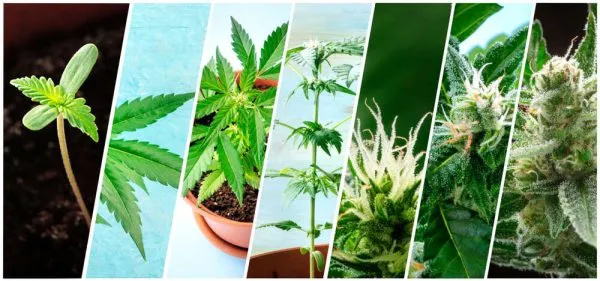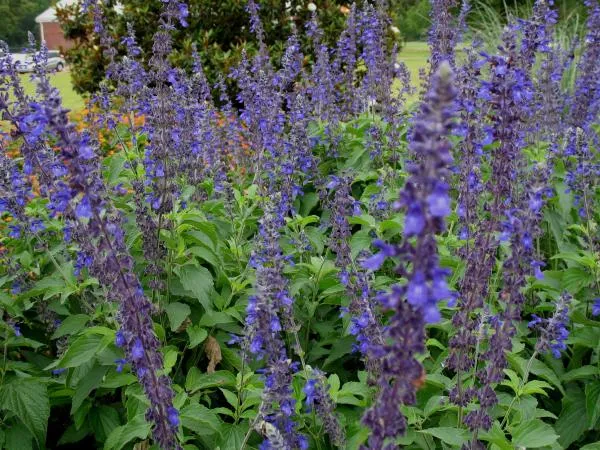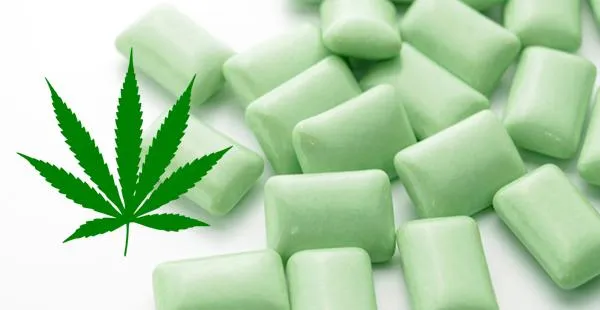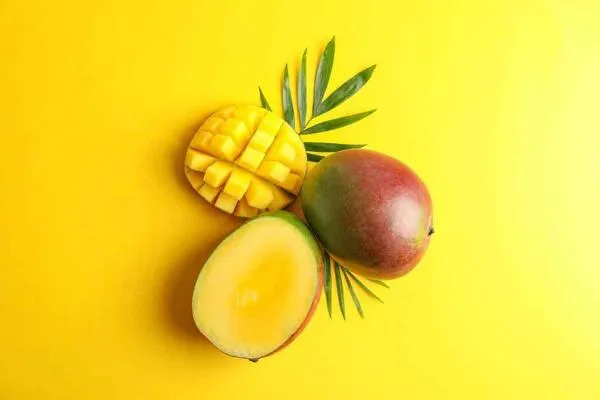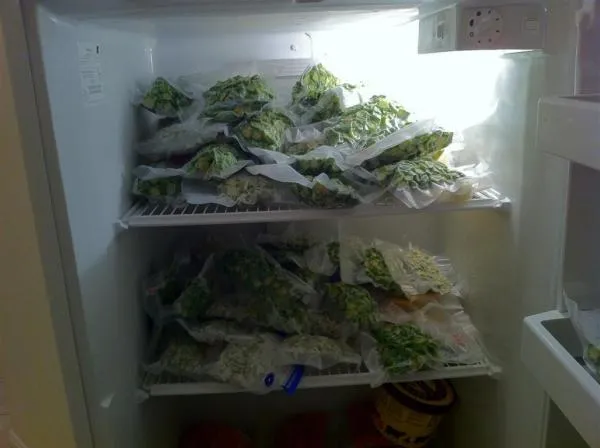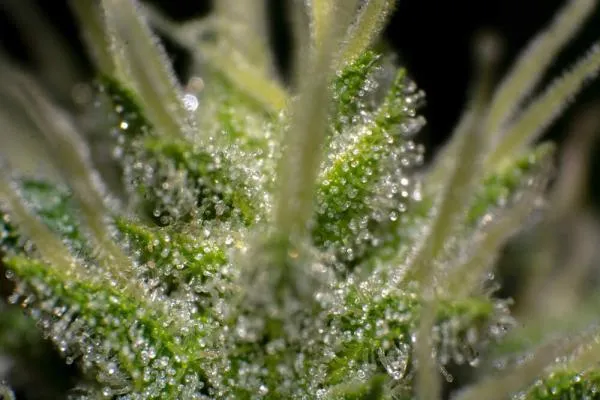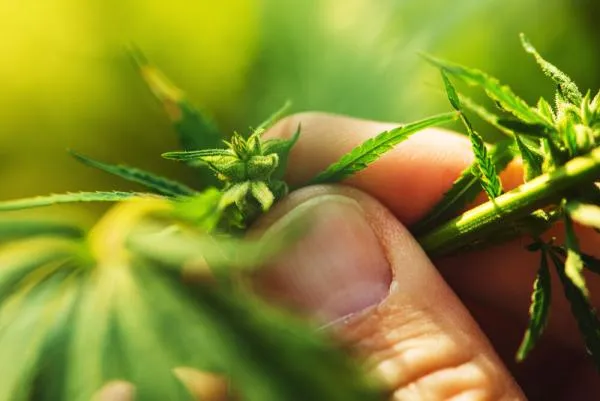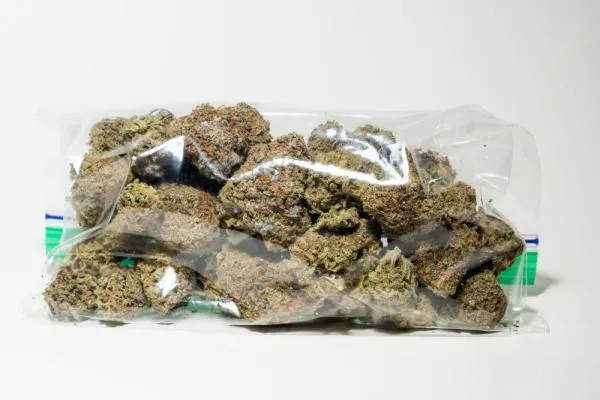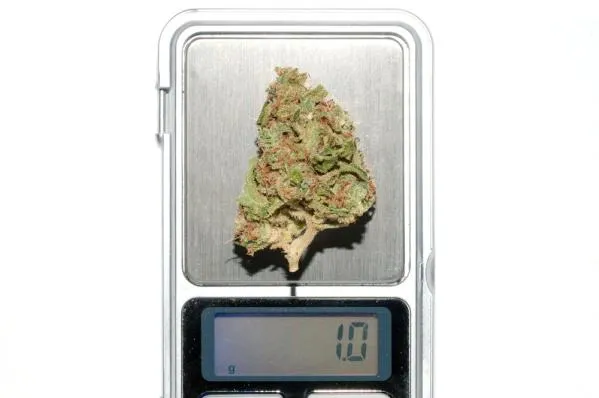There is a lot to learn if you want to master growing cannabis and as a beginner it can seem like a daunting task. But before you head off to your local dispensary, have a read of our beginner’s guide to growing weed.
At MSNL our bread and butter is growing cannabis, so where better to learn about the craft than from the experts themselves. We will walk you through the process of growing weed, from germinating your cannabis seeds right the way through to harvesting and drying your bud. Along the way you'll learn how to choose the right seeds, germinate them successfully, master each stage of growth, and finally, harvest your flower.
- What medium is best for growing weed?
- What is the easiest way to germinate cannabis seeds
- How to grow weed during the seedling stage
- How to Grow Weed During the Vegetative Stage
- How to Grow Weed During the Flowering Stage
- How to Harvest Your Weed
- Which Cannabis Seeds Should You Use?
- What is the Ideal Climate for Cannabis Plants?
- Cannabis Grow Lights
- What Nutrients Does a Cannabis Plant Need?
- Conclusion
What medium is best for growing weed?
Choosing the right growing medium is a good starting point. A medium includes soil, coco coir, hydroponics and anything you choose to grow your cannabis plant in. The growing medium acts as the home for the roots and root health is paramount if you want to grow big, healthy marijuana plants.
Soil: This is the most natural and beginner-friendly medium. It's rich in nutrients and provides a forgiving environment if you make a mistake with watering or feeding. Organic potting soil, mixed with perlite for better drainage, is usually an excellent choice.
Hydroponics: This method involves growing plants in water instead of soil. The roots are effectively dangling in a reservoir of water and nutrients. The result is that nutrients are delivered directly to the plant roots, instead of them searching for it causing faster growth and bigger yields. However, it requires more equipment and expertise.
Coco Coir: Made from the husk of coconuts, coco coir is a sustainable and pH neutral medium. It retains water well, allowing roots to access moisture and nutrients easily. It's a popular choice for both soil-based and hydroponic systems.
Aeroponics: In this advanced method, plants are grown in an air or mist environment with no soil. Nutrients are sprayed directly onto the roots, which can lead to rapid growth. However, it's not beginner-friendly and needs precise control over the environment.
Each medium has its own pros and cons, so your choice will depend on your skill level, budget, and the resources you have available.
What is the easiest way to germinate cannabis seeds
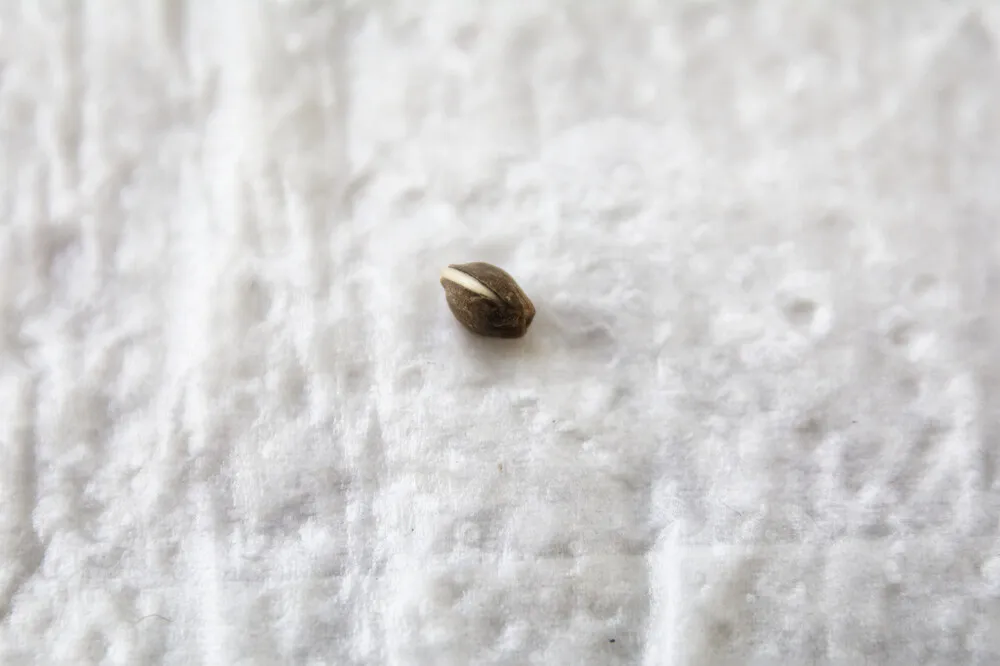
Plant Age: 0 - 1 weeks
Seedling Stage Temperature: 70 - 75° F
Seedling Stage Humidity: 70% - 80%
The paper towel method is widely recognized as one of the easiest and most effective method to germinate cannabis seeds. Here's a step-by-step guide:
Step 1: Prepare your supplies. You'll need two clean plates, paper towels, and of course, your cannabis seeds.
Step 2: Place 3-4 layers of paper towels on one of the plates. These will serve as a bed for your seeds.
Step 3: Moisten the paper towels with distilled water. They should be damp but not soaking wet. Too much water can drown the seeds.
Step 4: Place your seeds on the damp paper towel, leaving some space between each seed to prevent them from touching and potentially damaging each other.
Step 5: Cover the seeds with another sheet of damp paper towel.
Step 6: Place the second plate upside-down over the first one, creating a dome-like environment for your seeds. This will help maintain the necessary humidity and temperature.
Step 7: Store the plates in a warm, dark place. Ideal temperatures are around 21 to 24 degrees Celsius (70 to 75 degrees Fahrenheit).
Step 8: Check your seeds daily. Make sure the paper towels remain moist and add more water if necessary. Within 36 to 72 hours, you should see the seeds starting to sprout or "pop".
This method is popular because it allows you to monitor the seeds closely and make sure that they have popped before planting them. However, once your seeds have sprouted handle them with extreme care as you transfer them into the growing medium because this is one of the most common stages you can damage your plants.
How to grow weed during the seedling stage
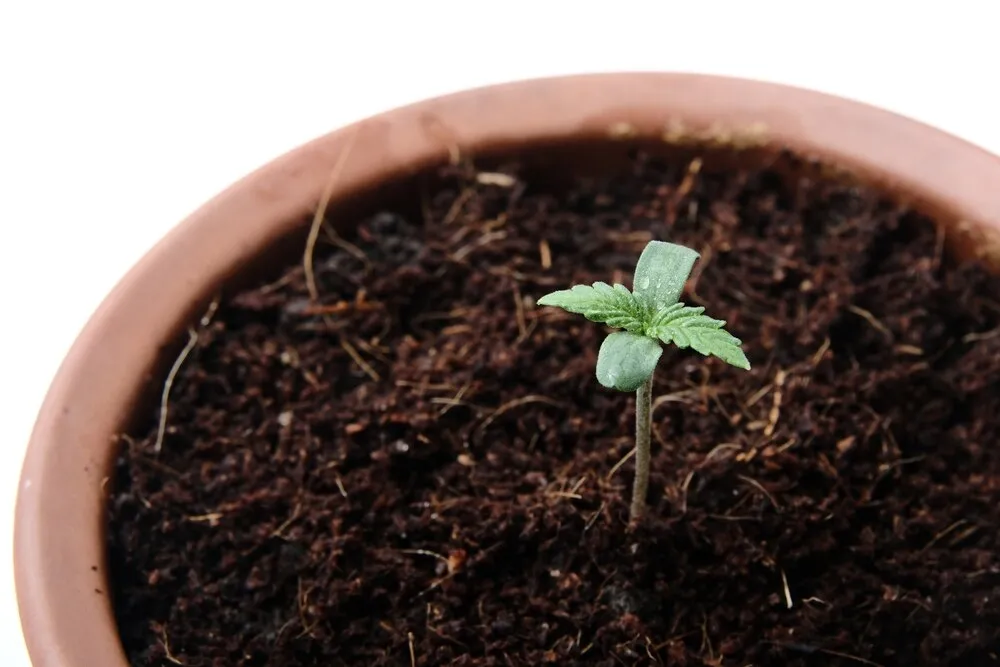
Plant Age: 1 - 2 weeks
Seedling Stage Temperature: 68 - 77° F
Seedling Stage Humidity: 65 - 70%
After successfully germinating your cannabis seeds, the next stage is the seedling phase. During this stage your seed emerges from the growing medium and produces its first set of tiny leaves known as cotyledons. The first set of leaves that a cannabis plant produces are round with smooth edges; these are just the starter set to give the plant enough energy to grow and gain strength. Here's how to care for your weed during the seedling stage:
Step 1: Transferring the Seedlings
Handle the sprouted seeds with utmost care when transferring them to their growing medium. The taproot (the little white root that comes out of your germinated seeds) is extremely delicate at this stage and can easily be damaged.
Step 2: Choosing the Right Growing Medium
You can choose from soil, coco coir, or a hydroponic setup. Each has its advantages and disadvantages. For beginners, soil is usually recommended due to its forgiving nature.
Step 3: Providing Light
Seedlings need plenty of light to grow. However, they are also sensitive to heat. Keep your lights about 24 inches above the seedlings to prevent burning them. If you're using fluorescent lights, they can be placed closer (about 3-4 inches away) because they don't emit much heat.
Step 4: Watering Your Seedlings
Overwatering is a common mistake among inexperienced growers. Seedlings don't need a lot of water. Wait until the top inch of soil is dry before watering again. Overwatering can cause the leaves to droop and may lead to root rot.
Step 5: Monitoring Temperature and Humidity
Cannabis seedlings prefer a temperature around 20-25 degrees Celsius (68-77 degrees Fahrenheit) and a relative humidity of 60-70%. A simple thermometer and hygrometer can help you maintain these conditions.
Step 6: Feeding Your Seedlings
Seedlings do not require additional nutrients if planted in nutrient-rich soil. If you're growing in a soilless medium, start feeding a weak nutrient solution (about 1/4 the recommended strength) once the seedlings have developed their first sets of leaves.
Step 7: Checking for Problems
Keep an eye out for common cannabis seedling problems like nutrient burn, overwatering, and pests. Early detection and correction can save your crop.
Remember, patience is key during the seedling stage. It might seem like your plants are growing very slowly, but they are establishing a robust root system underground. Once this foundation is set, your cannabis plants will start to grow rapidly.
How to Grow Weed During the Vegetative Stage
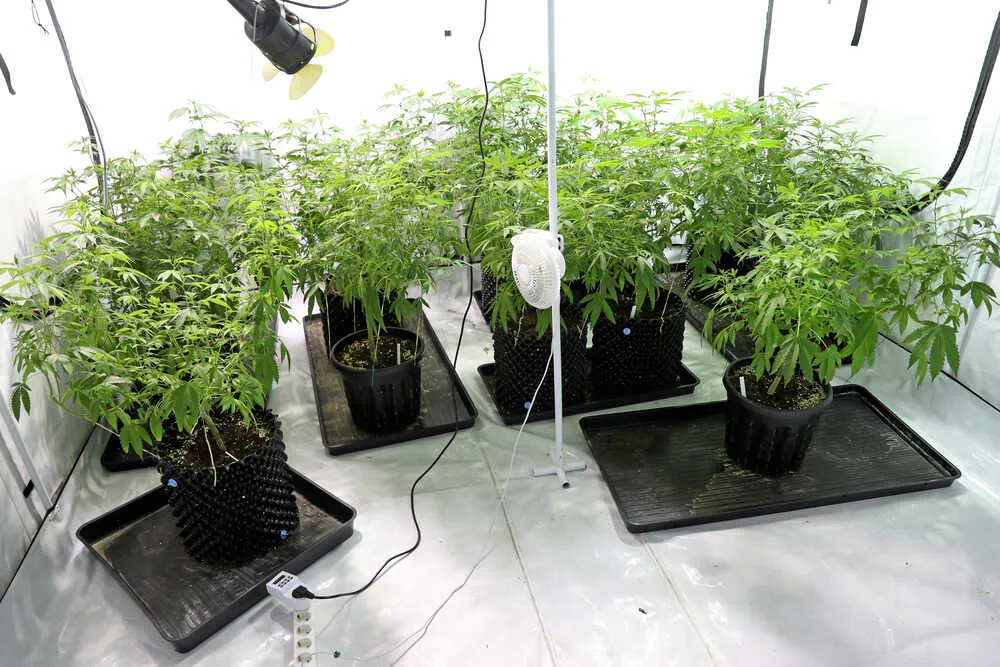
Plant Age: 2 - 7 weeks
Vegetative Stage Temperature: 71 - 82° F
Vegetative Stage Humidity: 40 - 70%
Once your seedlings have developed 3-4 sets of serrated edged leaves it has transitioned into the vegetative stage. The vegetative stage is a key period in your cannabis plant's life cycle. This is when your plant focuses on growing bigger and taller, establishing a strong root system, and developing full, healthy leaves. It is during the veg stage that you will be laying the foundations in preparation for a successful flowering stage. Here's how to grow weed during the vegetative stage:
Light Cycles
During the vegetative stage, cannabis plants need plenty of light to fuel their growth. If you are growing feminized photoperiod plants indoors you will need to set your grow lights to an 18/6 schedule (18 hours of light, followed by 6 hours of darkness) to replicate summertime. The vegetative stage for ordinary photoperiod cannabis plants lasts as long as you want. When growing indoors you are in control of switching to the flowering stage. However, most growers keep their plants in veg for 5-6 weeks.
If you are growing autoflowering cannabis seeds you can keep them on either 18/6, 20/4 or even 24 hours light and no dark. The main difference when growing autoflowering plants is that you do not need to change the lighting schedule to trigger the flowering stage. The autoflowering veg stage typically lasts for 3-5 weeks.
What Happens During the Vegetative Stage
The focus during the vegetative phase is on strengthening the stems of your cannabis plants so that they are strong enough to take the weight of the buds come the flowering phase. The aim is to also manipulate your plant with LST or HST training methods encouraging better light distribution and faster growth. Your plants will develop strong branches and large fan leaves to capture as much light as possible. It's during this time that the plant prepares itself for the flowering stage, where it will start producing buds.
Nutrient Needs
In the vegetative stage, your cannabis plants will require higher levels of nitrogen, along with adequate amounts of phosphorous and potassium. A typical NPK ratio for the veg stage is 3:1:1. They'll also need secondary and micronutrients such as calcium, magnesium, iron, and zinc. There are many pre-formulated nutrient mixes available that cater specifically to the needs of cannabis during this stage.
What to Look Out for
Watch out for signs of nutrient deficiencies or overfeeding, such as yellowing leaves or burnt leaf tips. Pests can also become a problem, so keep an eye out for discolored spots, holes in leaves, or the pests themselves. Check your plants regularly for signs of mold, mildew, or other diseases.
Low Stress Training (LST)
Low Stress Training is a technique used to maximize the plant's exposure to light and increase yield. By gently bending and tying down branches, you can create a flatter and wider canopy, allowing light to reach all parts of the plant. This method can help improve your yield without requiring additional resources.
Remember, the vegetative stage is all about setting your plants up for a successful flowering phase. By providing the right conditions and allowing your plant to grow big and strong you will give yourself the best possible chance of producing a nice big healthy harvest.
How to Grow Weed During the Flowering Stage
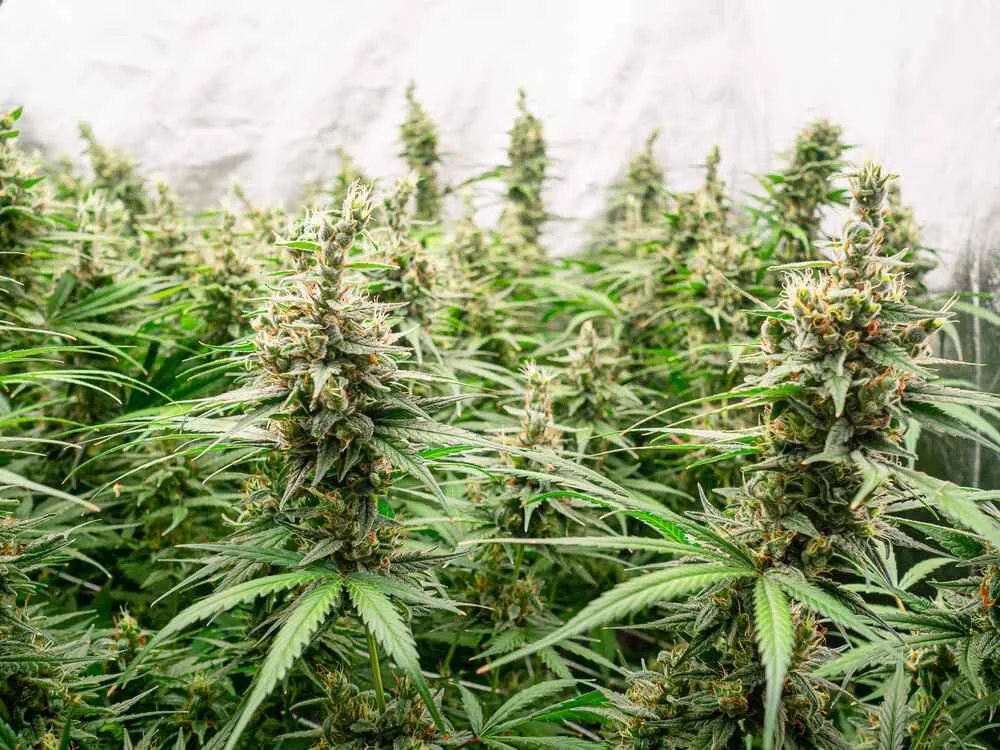
Plant Age: 7 - 15 weeks
Early - Mid Flowering Stage Temperature: 68 - 78° F
Early - Mid Veg Flowering Stage Humidity: 40 - 50%
Plant Age: 15 - 17 weeks
Late Flowering Stage Temperature: 65 - 75° F
Late Flowering Stage Humidity: 30 - 40%
The flowering stage is the final phase of a cannabis plant's life cycle. This is when your efforts will pay dividends as your plants start to develop buds. The aim of the flowering stage for you as a grower is to keep your plants happy, avoid any stress and provide them with the right nutrients to grow flowers. The more flowers your plant produces the bigger your yields will be.
Light Cycles
During the flowering stage, if you are growing ordinary feminized seeds your light schedule should change to 12 hours of light and 12 hours of uninterrupted darkness. This mimics the natural light cycle of fall, signaling to the plant that it's time to start producing flowers. Maintaining strict light cycles is crucial; any light leaks during the dark period can confuse the plant and potentially cause issues like hermaphroditism.
If you are growing autoflowers you do not need to worry about changing the light cycles, your autoflower plants should flower of their own accord at around 3-5 weeks of vegetative growth.
What Happens During the Flowering Stage
The flowering stage can be divided into two phases: pre-flowering and full flowering. In pre-flowering, you'll notice your plants starting to develop small bud sites and show their sex. Female plants produce little wispy white hairs known as pistils. Whereas male plants produce pollen sacs that you’ll want to avoid. If you are growing regular seeds, it is really important that you learn the skill of spotting the early signs of male sex so that you can either separate any male plants or cull them from your crop.
Once full flowering sets in, the plant focuses all its energy on producing and fattening up buds. The pistils will darken, and the buds will become coated with sticky, resinous crystals called trichomes, which contain the plant's cannabinoids.
Nutrient Needs
In terms of nutrients, cannabis plants require less nitrogen but more phosphorous and potassium during the flowering stage. Phosphorous is essential for bud development, while potassium helps with the overall health and vigor of the plant. Many cannabis-specific nutrient lines have a different mix specifically designed for the flowering stage. An example of a good NPK ratio to give your plants during the flowering stage is a 1:3:2 for early – mid flowering phase and then moving to a 0:3:3 ratio during the late flowering stage.
What to Look Out For
You should watch out for common problems such as nutrient burn, pests, and diseases. Bud rot, a type of mold, can be particularly devastating in the flowering stage. Regularly inspect your plant, paying close attention to the buds.
Also, keep an eye on your plant's trichomes. These tiny, mushroom-like structures will turn from clear to a milky white as the plant matures. When they're mostly milky with some amber, it's usually the optimal time to harvest for maximum potency.
How to Harvest Your Weed
Harvesting your cannabis plant is the final stage of growing weed but the period when most eager first-time growers rush and make mistakes. Getting the harvest stage right will massively influence the quality of your weed. The harvest stage can be broken down into 3 phases, cutting down your plants and trimming them, drying your buds and curing them. Here's how to do it right:
How Do You Know When the Buds Are Ripe?
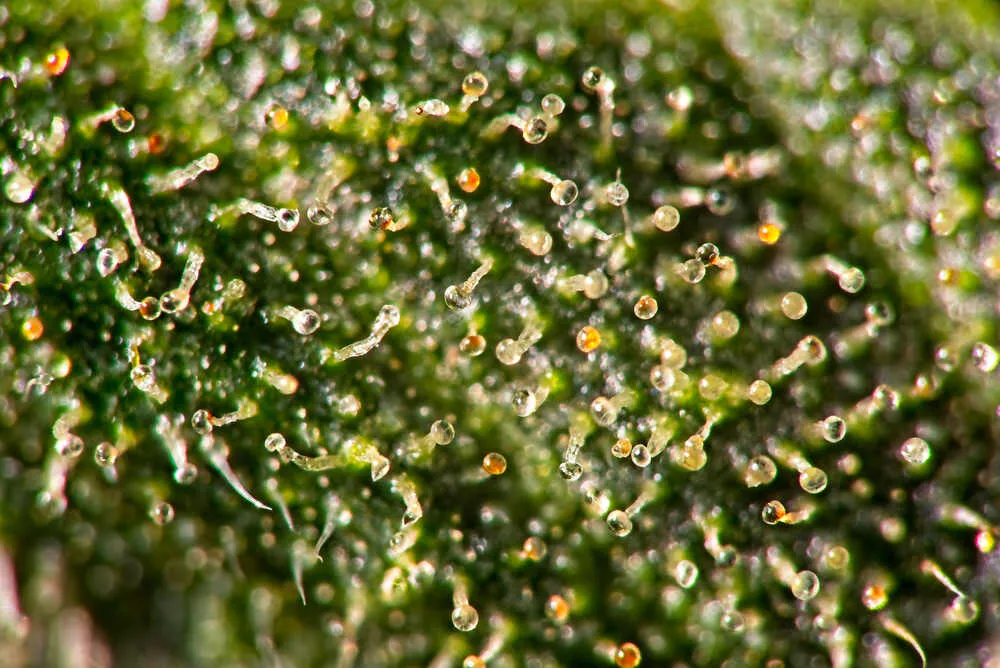
Knowing when to harvest and actually give your plants the chop is an important skill because it affects the potency and flavor of your buds. The most accurate way to tell if your buds are ripe is by looking at the trichomes—the small, crystal-like structures coating the buds.
Use a magnifying glass or a jeweler's loupe to inspect the trichomes. They'll begin to turn from clear to milky white as the plant matures. When most of the trichomes have turned milky and a few are amber-colored, it's usually the best time to harvest for maximum potency.
Apart from trichomes, you can also look at the pistils (the hair-like structures on the buds). When about 60-70% of the pistils have darkened and curled in, it's another sign that your plant might be ready for harvest.
Cutting Them Down and Drying
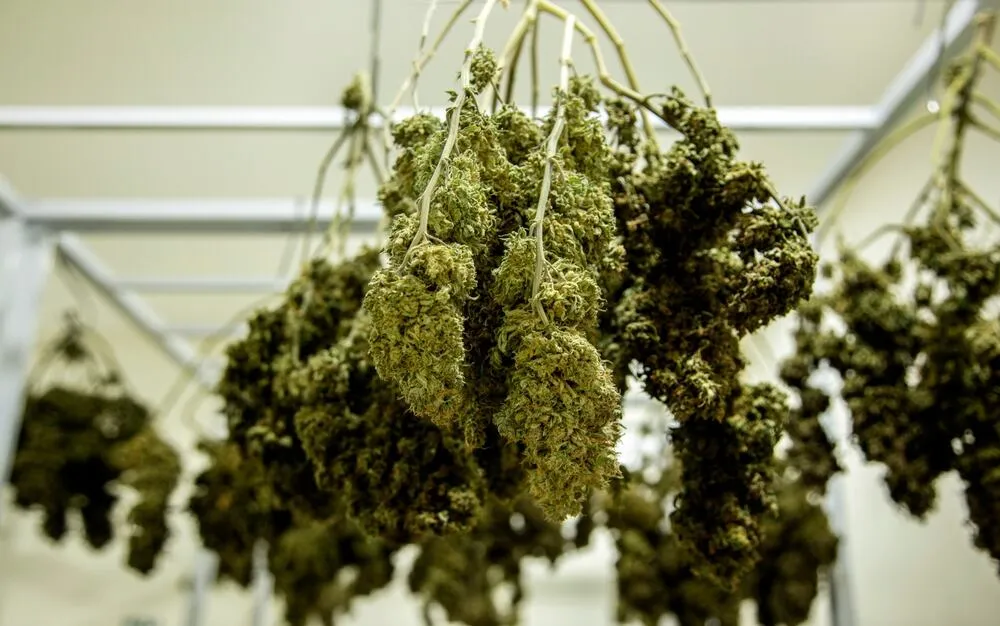
Drying Stage Temperature: 60 - 70° F
Drying Stage Humidity: 55 - 60%
When your plants are ready, cut down the branches one by one using clean, sharp scissors. Trim off the larger fan leaves first, as they don't contain trichomes and can make your buds harsh to smoke.
Next, hang the trimmed branches upside down in a dark, cool room with good ventilation. The drying process can take anywhere from a week to two weeks, depending on your local climate. Your buds are properly dried when the smaller stems snap instead of bend when you try to break them.
Curing Your Buds
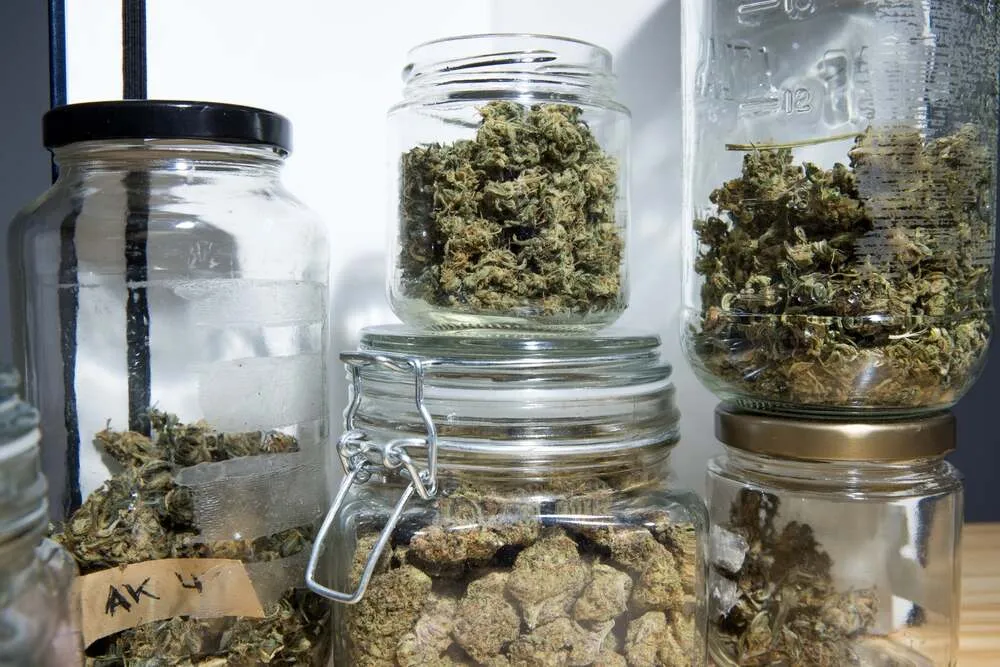
Curing Stage Temperature: 60 - 70° F
Curing Stage Humidity: 55 - 65%
Curing is the process of storing your buds in a controlled environment to further dry them out and enhance their quality. Proper curing will improve the smoothness, flavor, and potency of your buds.
Place your dried buds in airtight glass mason jars, filling them up to 75% to allow some air at the top. Store these jars in a dark, cool place. For the first week, open the jars once a day for a few minutes to let fresh air in and excess moisture out. After the first week, you can reduce this to once every few days.
Curing can take anywhere from two weeks to a few months. The longer you cure, the better the quality of your buds. Just remember to check your jars regularly for any signs of mold.
Which Cannabis Seeds Should You Use?
The main focus of any grow should be what genetics you want to cultivate. There are thousands strains available, but to make sure you have got the best cannabis seeds for you, do some research on what kind of weed you want to smoke, how much space you have available and if you are growing indoors or outdoors. Lets take a look at the types of cannabis seed you can grow.
Feminized, Autoflower or Regular?
Feminized Seeds: Feminized seeds have been modified to produce only female plants, which are the ones that produce smokeable bud. If you're a new to growing marijuana or want to guarantee a harvest without the worry of identifying and removing male plants, feminized seeds are a great choice as they eliminate the risk of male plants.
Autoflower Seeds: Autoflower cannabis seeds are a popular choice for those looking for a fast and easy to grow plant. Autoflowering plants automatically switch from the vegetative stage to the flowering stage after 3-5 weeks without you needing to change the light cycle. They also tend to be smaller and more compact, making them ideal for indoor growing.
Autoflowering and feminized strains are great for inexperienced growers, however, the easiest marijuana seeds to grow for beginners are autoflowering. This is simply because they are easy to maintain indoors because of the compact size and can even be grown on a window seal of balcony if you don't want to splash out on expensive equipment.
Regular Seeds: These will produce both male and female plants, so you will need to identify and remove male plants to prevent them from pollinating the females, which would result in seeded buds. The main use for regular seeds would be if you wanted to breed cannabis plants, in which case you need both a male and female plant.
Indica or Sativa?
Indica Strains: These are typically shorter, bushier plants with broad, dark green leaves. They grow faster and typically reach about 100-150cm tall. The buds produced by indica strains are known for their relaxing, body high, making them ideal for evening use or to help with conditions like insomnia or chronic pain.
Sativa Strains: Sativa plants are taller with thin, light-green leaves. They take longer to mature than indicas but are known for producing buds with uplifting, cerebral effects that stimulate creativity and social interaction. Sativa strains are often recommended for daytime use or to help with conditions like depression or fatigue.
What is the Ideal Climate for Cannabis Plants?
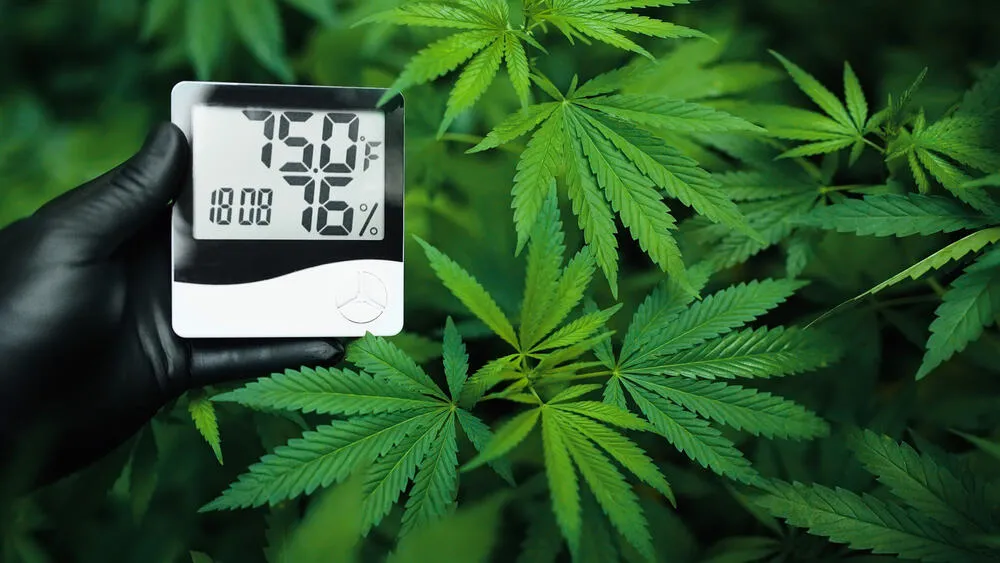
Creating the ideal climate for your cannabis is important so that they are not stressed while growing. Having a healthy and happy plant allows them to focus on photosynthesis, nutrient uptake, resulting in bigger yields.
Temperature:
The optimal temperature for cannabis plants depends on their stage of growth.
During the vegetative stage, cannabis plants thrive in slightly warmer conditions, typically between 70-85°F (21-29°C).
Once your plants enters the flowering stage, they prefer slightly cooler temperatures, ideally between 70-80°F (21-26°C).
Humidity:
In the seedling stage, cannabis plants prefer high humidity levels of around 70% as it aids in their root development.
As the plant grows into its vegetative stage, you should gradually reduce the humidity to around 40-70%. This reduction helps prepare the plant for the lower humidity levels in the flowering stage.
In the flowering stage, humidity levels low, around 40-50%, to prevent bud rot and other moisture-related diseases. Towards the end of the flowering stage, aim to decrease humidity further, to about 30-40%.
Environment:
Cannabis plants need a clean and controlled environment for optimal growth. Here are some factors to consider:
- Light: Cannabis plants need ample light for photosynthesis. Whether you're growing indoors under artificial lights or outdoors in natural sunlight, make sure your plants receive enough light without getting scorched.
- Air Circulation: Good airflow is essential to keep humidity levels in check and prevent the buildup of mold and pests. If you're growing indoors, consider using fans and vents. Outdoors, ensure your plants are not in a stagnant air environment.
- Protection from Extreme Conditions: Cannabis plants can be vulnerable to extreme weather conditions. High winds can break branches, heavy rains can cause waterlogged roots, and frost can kill a cannabis plant outright. Provide protection from these conditions where possible. If you're growing outdoors, consider using protective structures like greenhouses.
Cannabis Grow Lights
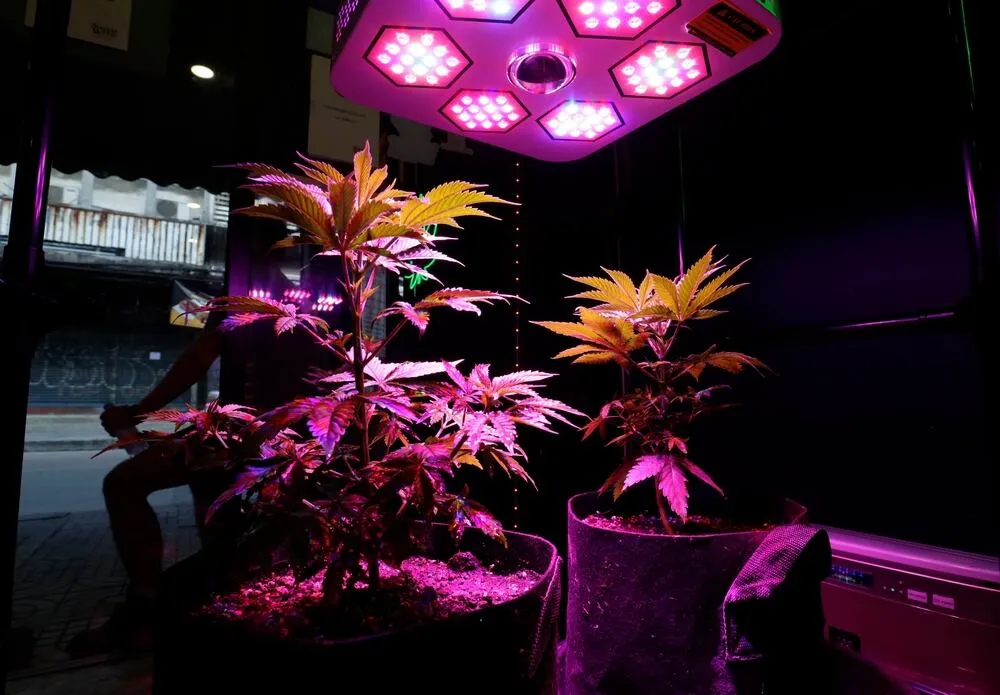
Light provides your plants with energy to grow, so it’s important particularly for indoor grows to get good quality full spectrum grow lights that replicate the sun.
How Much Light Do Cannabis Plants Need?
Cannabis plants need a lot of light, especially during the vegetative stage. During this stage, they will need at least 14 hours of light each day to grow big. Ideally if you are growing indoors then you should give them 18 hours of light per day.
What Light Cycles are Best for Photoperiods?
Photoperiod cannabis strains are those that depend on specific periods of light and darkness to transition from the vegetative to the flowering stage.
During the vegetative stage, these strains typically require a light cycle of 18 hours of light and 6 hours of darkness. Once you're ready for them to start flowering, you'll need to adjust the light cycle to 12 hours of light and 12 hours of darkness. This shift signals the plant to start producing buds.
What Light Cycles are Best for Autoflowers?
Autoflowering cannabis strains automatically switch from the vegetative stage to the flowering stage after a certain period, regardless of the light cycle.
However, they still require plenty of light to grow well. Most autoflower growers provide 18-24 hours of light throughout the entire life cycle of the plant. While this may seem excessive, autoflowers have been bred to handle this amount of light, and the extra energy can lead to bigger yields.
Indoor Grow Lights
There are several types of grow lights you can use for indoor cannabis cultivation:
- High-Intensity Discharge (HID) Lamps: These are considered highly effective for growing cannabis, providing a good ratio of yield to watts used. HID lamps include both Metal Halide (MH) lamps, which are ideal for the vegetative stage, and High-Pressure Sodium (HPS) lamps, which are perfect for the flowering stage.
- Light-Emitting Diode (LED) Lights: These are increasingly popular due to their energy efficiency and full spectrum of light. They can be used throughout the entire growth cycle of the plant.
- Fluorescent Bulbs: While not as powerful as HID or LED lights, fluorescent bulbs like Compact Fluorescent Lights (CFLs) and T5 tubes are a good option for small-scale growers or for use as supplemental lighting.
Which Grow Lights are Best for Beginners?
For beginners, LED lights might be the best option. While they have a higher upfront cost, they are energy-efficient, easy to set up, and can be used throughout the entire life cycle of the plant. They also produce less heat than HID lamps, reducing the risk of heat stress.
What Nutrients Does a Cannabis Plant Need?
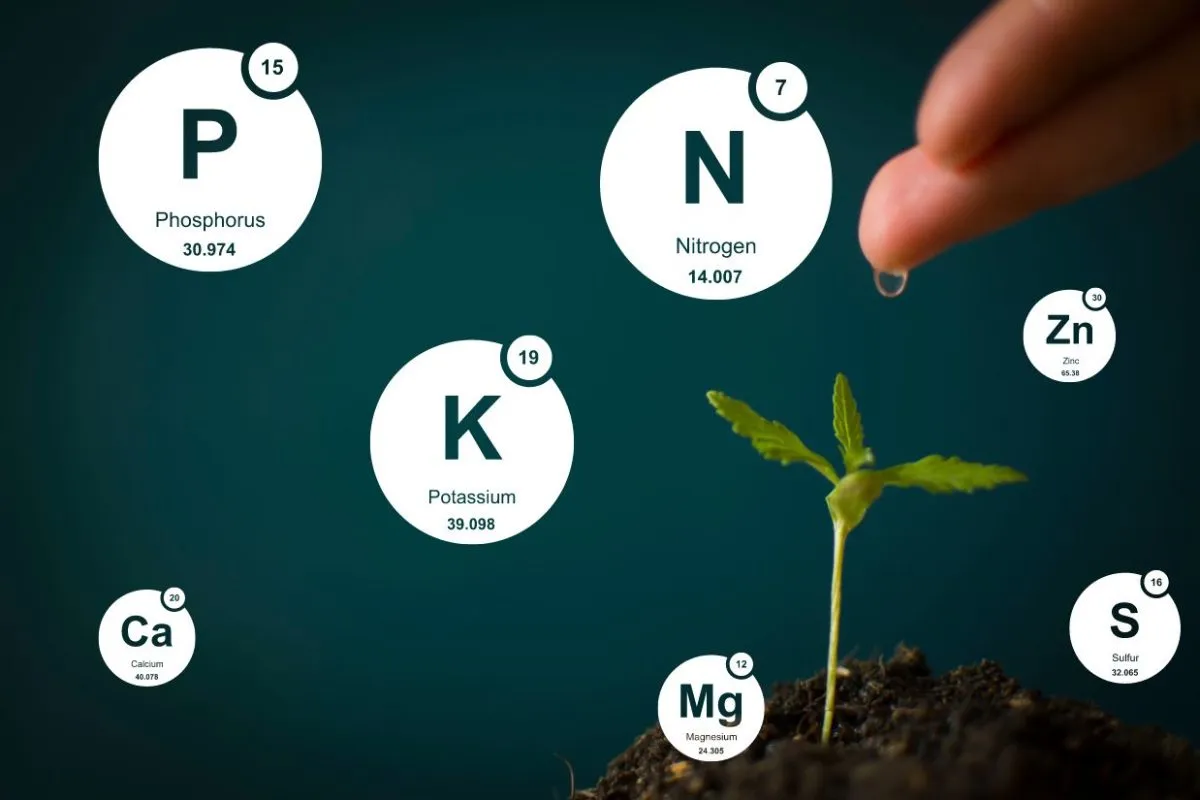
Like all plants, cannabis requires certain nutrients to thrive. These nutrients are typically divided into two categories: macronutrients and micronutrients. Let's delve into each category:
NPK: The Macro Nutrients for Cannabis Plants
The primary macronutrients that cannabis plants need are Nitrogen (N), Phosphorus (P), and Potassium (K). These elements are crucial for the plant's growth, flowering, and overall health.
Nitrogen (N): This nutrient is essential for the vegetative stage of cannabis growth. It's a major component of chlorophyll, which the plant uses to convert sunlight into energy during photosynthesis. Nitrogen also plays a significant role in protein synthesis. A nitrogen deficiency can lead to yellowing leaves.
Phosphorus (P): Phosphorus is vital during the flowering stage. It aids in the development of roots and flowers and contributes to the plant’s ability to convert other nutrients into usable building blocks. A lack of phosphorus can lead to stunted plant growth or reduced yield.
Potassium (K): Potassium helps regulate the plant’s overall functions, including the opening and closing of stomata (pores), water uptake, and resistance to disease. It is important throughout the plant's life but is particularly crucial during the flowering stage. A potassium deficiency can lead to weak stems and slow growth.
It's essential to maintain a balance of these nutrients. Too much of one can cause a deficiency of another. The specific ratios needed can vary depending on the stage of growth and the specific strain of cannabis you're growing.
Micronutrients for Cannabis Plants
In addition to NPK, cannabis plants also require several micronutrients, albeit in smaller amounts. These include:
Calcium: This nutrient aids in cell wall development and overall plant strength.
Magnesium: Magnesium is a component of chlorophyll and aids in photosynthesis.
Sulfur: Sulfur helps in the production of vitamins, amino acids, and enzymes.
Trace Elements: Cannabis plants also need trace amounts of iron, boron, manganese, zinc, copper, molybdenum, and chlorine.
Conclusion
And there you have it! From seed to weed this guide has given you a roadmap grow your cannabis plants. Don't forget to spread the knowledge - like and share this article!
